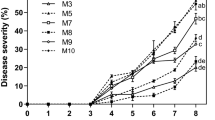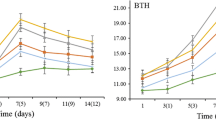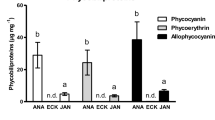Abstract
The known plant defence activators acibenzolar-S-methyl (ASM) and methyl jasmonate (MeJA) were applied as spray and as spray or pulse treatments, respectively, after harvest and evaluated for efficacy against freesia cv. ‘Cote d’Azur’ flower specking disease caused by the pathogen Botrytis cinerea. Lesion numbers on non-inoculated freesia flowers and lesion diameters on attached petals of inoculated flowers were reduced by 1.43, 2.86 and 5.72mM ASM at 5 and 12°C compared with untreated controls. However, ASM was ineffective in reducing lesion numbers and lesion diameters on non-inoculated and on artificially inoculated flowers incubated at 20?C. ASM showed direct antimicrobial activity in vitro, significantly reducing B. cinerea mycelial growth and conidial germ tube elongation. ASM treatments did not adversely affect the vase life of cut freesia flowers. MeJA applied as postharvest spray or pulse to freesia flowers also tended to suppress B. cinerea. MeJA treatments at 12 and 20°C were generally more effective than at 5°C. In contrast to ASM, MeJA usually did not exert direct antimicrobial activity against B. cinerea in vitro. MeJA spray treatment leads to an increase in relative fresh weight and a reduction of wilt scores of flowers during the vase life. In contrast, MeJA pulsing at 0.6mM reduced relative fresh weight and vase life of cut freesia flowers compared with untreated controls. Overall, the results suggest a potential role for postharvest ASM spray and MeJA spray or pulse treatments in suppressing B. cinerea on cut freesia flowers. However, variable efficacy needs to be overcome before such plant defence activator treatments could be used in commercial practice.
Similar content being viewed by others
References
Adikaram NKB, Joyce DC, Terry LA (2002) Biocontrol activity and induced resistance as a possible mode of action for Aureobasidium pullulans against grey mould of strawberry fruit. Australasian Plant Pathology 31, 223–229. doi: 10.1071/AP02017
Buta JG, Moline HE (1998) Methyl jasmonate extends shelf life and reduces microbial contamination of fresh-cut celery and peppers. Journal of Agricultural and Food Chemistry 46, 1253–1256. doi: 10.1021/jf9707492
Darras AI, Joyce DC, Terry LA (2004) A survey of possible associations between preharvest environment conditions and postharvest rejections of cut freesia flowers. Australian Journal of Experimental Agriculture 44, 103–108. doi: 10.1071/EA03025
Darras AI, Terry LA, Joyce DC (2005) Methyl jasmonate vapour treatment suppresses specking caused by Botrytis cinerea on cut Freesia hybrida L. flowers. Postharvest Biology and Technology 38, 175–182. doi: 10.1016/j.postharvbio.2005.06.011
Darras AI, Joyce DC, Terry LA, Vloutoglou I (2006) Postharvest infection of Freesia hybrida flowers by Botrytis cinerea. Australasian Plant Pathology 35, 55–63. doi: 10.1071/AP05103
Dhingra OD, Sinclair JB (1995) ‘Basic plant pathology methods.’ 2nd edn. (CRC Press: Boca Raton, FL)
Droby S, Porat R, Cohen L, Weiss B, Shapiro B, Philosoph-Hadas S, Meir S (1999) Suppressing green mold decay in grapefruit with postharvest jasmonate application. Journal of the American Society for Horticultural Science 124, 184–188.
Gast K (2001) Methyl jasmonate and long term storage of fresh cut peony flowers. Acta Horticulturae 543, 327–330.
Gonzalez-Aguilar GA, Buta JG, Wang CY (2003) Methyl jasmonate and modified atmosphere packaging (MAP) reduce decay and maintain postharvest quality of papaya ‘Sunrise’. Postharvest Biology and Technology 28, 361–370. doi: 10.1016/S0925-5214(02)00200-4
Gonzalez-Aguilar GA, Tiznado-Hernandez ME, Zavaleta-Gatica R, Martinez-Tellez MA (2004) Methyl jasmonate treatments reduce chilling injury and activate the defense response of guava fruits. Biochemical and Biophysical Research Communications 313, 694–701. doi: 10.1016/j.bbrc.2003.11.165
Huang Y, Deverall BJ, Tang WH, Wang W, Wu FW (2000) Foliar application of acibenzolar-S-methyl and protection of postharvest rock melons and Hami melons from disease. European Journal of Plant Pathology 106, 651–656. doi: 10.1023/A:1008767719691
Il’inskaya LI, Goenburg EV, Chalenko GI, Ozeretskovskaya OL (1996) Involvement of jasmonic acid in the induction of potato resistance to Phytophthora infection. Russian Journal of Plant Physiology 43, 622–628.
Jarvis WR (1980) Epidemiology. In ‘The biology of Botrytis’. (Eds JR Coley-Smith, K Verhoeff, WR Jarvis) pp. 219–245. (Academic Press:York,UK)
Joyce DC, Jones PN (1992) Water balance of the foliage of cut Geraldton waxflower. Postharvest Biology and Technology 2, 31–39. doi: 10.1016/0925-5214(92)90025-K
Kessmann H, Staub T, Hofmann C, Maetzke T, Herzog J (1994) Induction of systemic acquired disease resistance in plants by chemicals. Annual Review of Phytopathology 32, 439–459. doi: 10.1146/annurev.py.32.090194.002255
Meir S, Droby S, Davidson H, Alsvia S, Cohen L, Horev B, Philosoph-Hadas S (1998) Suppression of Botrytis rot in cut rose flowers by postharvest application of methyl jasmonate. Postharvest Biology and Technology 13, 235–243. doi: 10.1016/S0925-5214(98)00017-9
Meir S, Droby S, Kochanek S, Salim S, Philosoph-Hadas S (2005) Use of methyl jasmonate for suppression of Botrytis rot in various cultivars of cut rose flowers. Acta Horticulturae 669, 91–98.
Pappas AC (1997) Evolution of fungicide resistance in Botrytis cinerea in protected crops in Greece. Crop Protection 16, 257–263. doi: 10.1016/S0261-2194(96)00096-8
Pommer E-H, Lorenz G (1982) Resistance of Botrytis cinerea Pers. to carboximide fungicides — a literature review. Crop Protection 1, 221–230. doi: 10.1016/0261-2194(82)90044-8
Steel CC, Nair NG (1993) The physiological basis of resistance to the dicarboximide fungicide iprodione in Botrytis cinerea. Pesticide Biochemistry and Physiology 47, 60–68. doi: 10.1006/pest.1993.1063
Terry LA, Joyce DC (2000) Suppression of grey mould on strawberry fruit with the chemical plant activator acibenzolar. Pest Management Science 56, 989–992. doi: 10.1002/1526-4998(200011)56:11〈989::AID-PS229〉 3.0.CO;2-A
Terry LA, Joyce DC (2004) Elicitors of induced disease resistance in postharvest horticultural crops: a brief review. Postharvest Biology and Technology 32, 1–13. doi: 10.1016/j.postharvbio.2003.09.016
Terry LA, Joyce DC (2007) Influence of growing conditions and associated variable efficacy of acibenzolar in suppression of Botrytis cinerea on strawberry fruit. Advances in Strawberry Research, in press.
Thomma BPHJ, Eggermont K, Broekaert W, Cammue BPA (2000) Disease development of several fungi on Arabidopsis can be reduced by treatment with methyl jasmonate. Plant Physiology and Biochemistry 38, 421–427. doi: 10.1016/S0981-9428(00)00756-7
Walters D, Walsh D, Newton A, Lyon G (2005) Induced resistance for plant disease control: maximising the efficacy of resistance elicitors. Phytopathology 95, 1368–1373.
Yao H, Tian S (2005) Effects of pre- and post-harvest application of salicylic acid or methyl jasmonate on inducing disease resistance of sweet cherry fruit storage. Postharvest Biology and Technology 35, 253–262. doi: 10.1016/j.postharvbio.2004.09.001
Author information
Authors and Affiliations
Corresponding author
Rights and permissions
About this article
Cite this article
Darras, A.I., Joyce, D.C., Terry, L.A. et al. Efficacy of postharvest treatments with acibenzolar-S-methyl and methyl jasmonate against Botrytis cinerea infecting cut Freesia hybrida L. flowers. Australasian Plant Pathology 36, 332–340 (2007). https://doi.org/10.1071/AP07030
Received:
Accepted:
Issue Date:
DOI: https://doi.org/10.1071/AP07030




